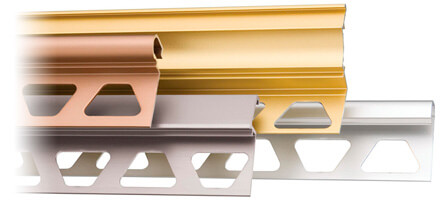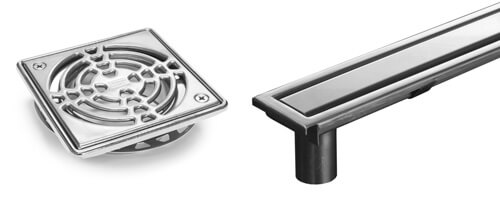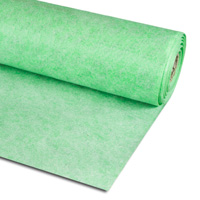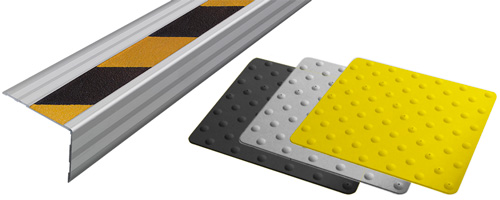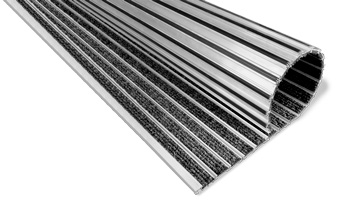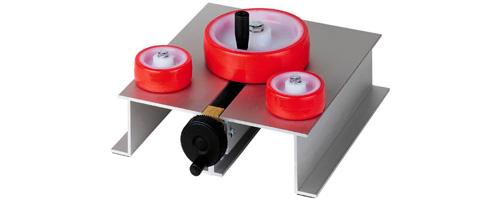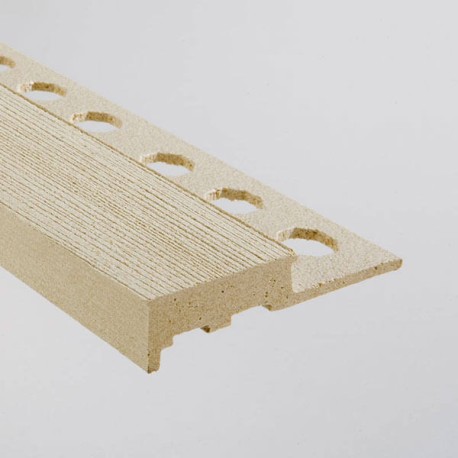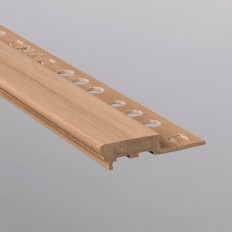Stair tread profiles or stair nosing made of Maxi, a material belonging to the WPC (Wood Plastic Composites) family that incorporates vegetable fibers in its composition and thus contributes to preserving the environment. Maxi is a very resistant material that has been subjected to multiple tests to certify its excellent properties.
The surface of the Novopeldaño MaxiDakar stair edge protectors is ribbed, which gives it a high resistance to sliding. This value contributes to CTE compliance since the installation of this step profile improves the Rd of the pavements it complements.
The MaxiDakar range has a simple and elegant design, with straight lines, allowing it to adapt to the latest trends in environments. In addition, the absence of bocel allows its placement on stairs of public buildings, in compliance with current regulations.
The MaxiDakar rung profiles are especially recommended for outdoor installation as it has excellent weathering behavior, remaining unaltered to sun exposure. It can even be used as a pool edge.
The absence of bocel allows its placement on stairs of public buildings, in compliance with current regulations. The MaxiDakar rung profiles are especially recommended for outdoor installation as it has excellent weathering behavior, remaining unaltered to sun exposure. It can even be used as a pool edge.
Available in almond, cinnamon, cocoa, ash and black colors.
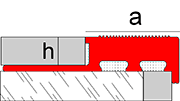
Dimensions
- h: 10/12 mm
- a: 40 mm
- Length: 2.50 m
Technical characteristics and tests
- Resistance to chemical agents: Very good except for acetone, chromic and sulfuric acid.
- Water absorption: Very small absorption, great dimensional stability. Retains its weight after drying.
- Reaction to fire: Efl / UNE 23.727-90 1R
- Abrasion resistance: No surface variation up to 2200 cycles / UNE EN 438-2: 2005Apt. 2. 3
- Superficial resistance to staining: Resistance to Acetone, coffee at 80ºC, bitumen, 30% hydrogen peroxide and 25% sodium hydroxide | Acetone: surface breakdown and blisters | Rest: without alteration. / UNE EN 438-2: 2005 Apt. 2. 3
- Impact resistance: Spring: 34 N / Ball drop: 120 cm. drop height / 9.9 mm tread diameter / UNE EN 438-2: 2005 Aptdo. 2. 3
- Cigarette burns: superficial degradation / UNE EN 438-2: 2005 Aptdo. 2. 3
- Humidity - drying:> 20 cycles / UNE EN 14428
- Slip resistance: It improves or equals the coefficient of slip resistance of the pavement to which they complement. / UNE-ENV 12633: 2003
- Slip resistance Footwear foot: It improves or equals the coefficient of slip resistance of the pavement they complement. / DIN 51130
Placement
- Spread plenty of grip material on the riser surface
- Place the tile on the riser and press for optimal adherence
- Next, spread plenty of gripping material on the tread tread and align the profile on the tread vertex so that it rests on the riser (do not allow overhang, the lever effect could tear off the tread and tiling). Press for the gripping material to pass through the fixation wing dies
- In installations with joint to head or joints between profiles, it is recommended to maintain a separation as an expansion joint, which should be greater the longer the profiles to be joined, approximately 2 mm / m. This joint can be sealed with elastic joint filler putty suitable for outdoor
- Place the tile on the tread of the step, aligning it with the profile and ensuring optimum adhesion. 6. Remove any possible material remains and allow to dry.
Warnings
- Because part of the raw material that makes up the Maxi is natural, there may be differences in tone that should not be considered a manufacturing defect.
- It is advisable to take the piece by its central area, avoiding holding it by the ends to avoid bending stresses that could cause cracks or breakage.
- Do not over bend the material. Always store it horizontally and in dry places.
- It should not be sanded, since it would affect its surface appearance. Interior Exterior Flooring Recyclable Page 3 of 3
- It resists well in humid conditions but its submerged use is not recommended.
- The MaxiKenya range is especially recommended for outdoors, since it has excellent resistance to weathering and remains unchanged in the sun.
- Maxi material, like other construction materials, can suffer dimensional variations derived from environmental thermal changes. In outdoor placement, you should avoid installing it during the hottest or coldest hours of the day, since it could suffer a greater dimensional variation than usual with the temperature variation. It is recommended to leave the material for a few hours at room temperature outside its packaging and always away from heat sources such as direct insolation.
Cleaning and maintenance
Maxi cleaning can be done with a cloth dampened with water or in solution with 5% neutral detergent.
The correct use of bleach does not affect the material. The use of chromic, sulfuric acid or polar solvents such as toluene or acetone is not recommended for cleaning.

